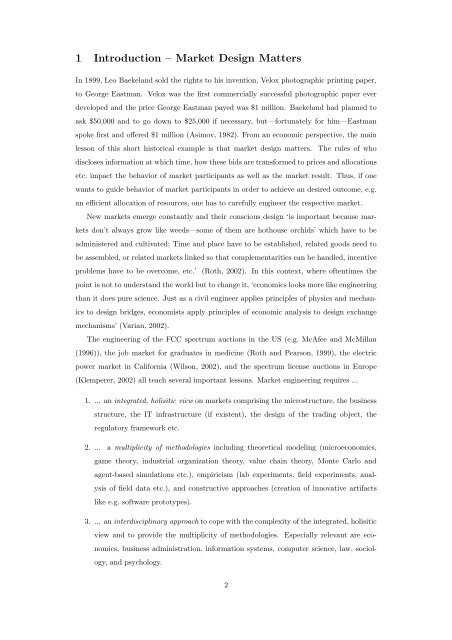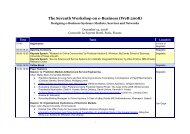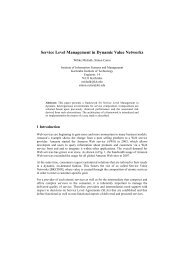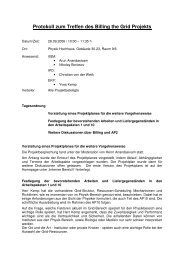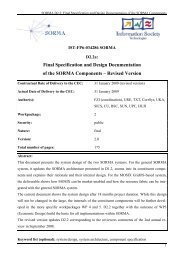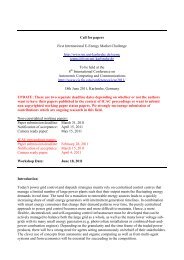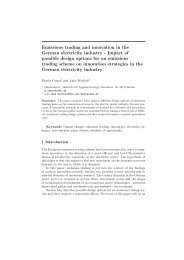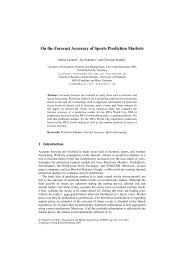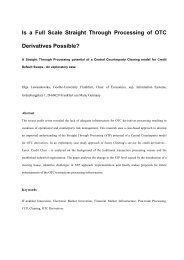Market Engineering - KSRI - Karlsruhe Service Research Institute - KIT
Market Engineering - KSRI - Karlsruhe Service Research Institute - KIT
Market Engineering - KSRI - Karlsruhe Service Research Institute - KIT
Create successful ePaper yourself
Turn your PDF publications into a flip-book with our unique Google optimized e-Paper software.
1 Introduction – <strong>Market</strong> Design Matters<br />
In 1899, Leo Baekeland sold the rights to his invention, Velox photographic printing paper,<br />
to George Eastman. Velox was the first commercially successful photographic paper ever<br />
developed and the price George Eastman payed was $1 million. Baekeland had planned to<br />
ask $50,000 and to go down to $25,000 if necessary, but—fortunately for him—Eastman<br />
spoke first and offered $1 million (Asimov, 1982). From an economic perspective, the main<br />
lesson of this short historical example is that market design matters. The rules of who<br />
discloses information at which time, how these bids are transformed to prices and allocations<br />
etc. impact the behavior of market participants as well as the market result. Thus, if one<br />
wants to guide behavior of market participants in order to achieve an desired outcome, e.g.<br />
an efficient allocation of resources, one has to carefully engineer the respective market.<br />
New markets emerge constantly and their conscious design ‘is important because markets<br />
don’t always grow like weeds—some of them are hothouse orchids’ which have to be<br />
administered and cultivated; Time and place have to be established, related goods need to<br />
be assembled, or related markets linked so that complementarities can be handled, incentive<br />
problems have to be overcome, etc.’ (Roth, 2002). In this context, where oftentimes the<br />
point is not to understand the world but to change it, ‘economics looks more like engineering<br />
than it does pure science. Just as a civil engineer applies principles of physics and mechanics<br />
to design bridges, economists apply principles of economic analysis to design exchange<br />
mechanisms’ (Varian, 2002).<br />
The engineering of the FCC spectrum auctions in the US (e.g. McAfee and McMillan<br />
(1996)), the job market for graduates in medicine (Roth and Pearson, 1999), the electric<br />
power market in California (Wilson, 2002), and the spectrum license auctions in Europe<br />
(Klemperer, 2002) all teach several important lessons. <strong>Market</strong> engineering requires ...<br />
1. ... an integrated, holisitic view on markets comprising the microstructure, the business<br />
structure, the IT infrastructure (if existent), the design of the trading object, the<br />
regulatory framework etc.<br />
2. ... a multiplicity of methodologies including theoretical modeling (microeconomics,<br />
game theory, industrial organization theory, value chain theory, Monte Carlo and<br />
agent-based simulations etc.), empiricism (lab experiments, field experiments, analysis<br />
of field data etc.), and constructive approaches (creation of innovative artifacts<br />
like e.g. software prototypes).<br />
3. ... an interdisciplinary approach to cope with the complexity of the integrated, holisitic<br />
view and to provide the multiplicity of methodologies. Especially relevant are economics,<br />
business administration, information systems, computer science, law, sociology,<br />
and psychology.<br />
2


